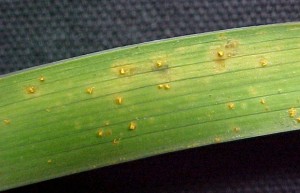Daylily rust – Puccinia hemerocallidis
Pathogen: Puccinia hemerocallidis
Hosts: Hemerocallis, Patrina (alternate host)
Symptoms: Raised yellowish-orange, powdery pustules on the surface of infected foliage. Significant foliar dieback occurs on especially susceptible cultivars.
Spread: Spores can be dispersed by wind or air movement. Movement of infected plant material is responsible for much of the long distance dissemination of this pathogen. This pathogen is not known to survive the winter in the northern areas of the U.S.
Management: Do not move or transport infected plant material. Carefully inspect incoming plant material for signs of rust. Fungicide applications are needed for disease management, especially on susceptible cultivars. Contact your local extension office for information on ratings of cultivar susceptibility and current fungicide control recommendations.

Other Documents in this Series
You Might Also Be Interested In
Accessibility Questions:
For questions about accessibility and/or if you need additional accommodations for a specific document, please send an email to ANR Communications & Marketing at anrcommunications@anr.msu.edu.



 Print
Print Email
Email




